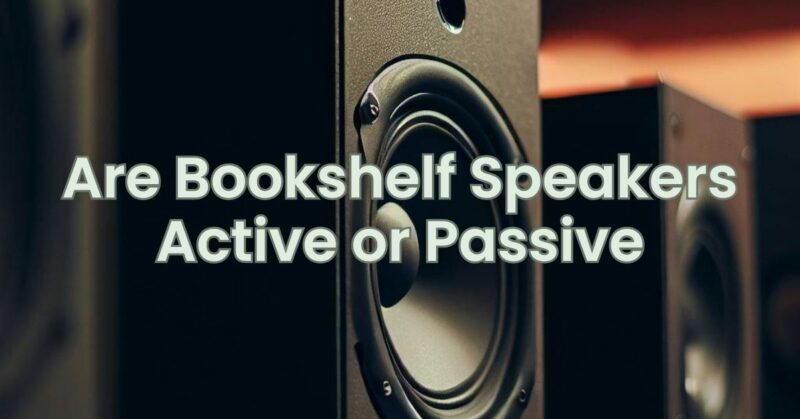When shopping for bookshelf speakers, one important consideration is whether they are active or passive. Understanding the difference between these two types of speakers is crucial in making an informed decision about the best option for your audio setup. In this article, we will explore the distinction between active and passive bookshelf speakers, highlighting their features, benefits, and considerations.
Active Bookshelf Speakers
Active bookshelf speakers, also known as powered speakers or self-powered speakers, have built-in amplifiers. This means they do not require an external amplifier or receiver to operate. Active speakers are designed as standalone units, often with dedicated inputs, volume controls, and sometimes even additional features like Bluetooth connectivity or built-in digital signal processing (DSP). They typically have a power source, such as a wall plug, to provide power to both the speaker drivers and the built-in amplifier.
Advantages of Active Bookshelf Speakers:
- Convenience: Active speakers eliminate the need for a separate amplifier or receiver, simplifying the setup process. They are an all-in-one solution that can be connected directly to audio sources like computers, smartphones, or turntables without requiring additional equipment.
- Integrated Amplification: Active speakers come with built-in amplifiers that are specifically matched to the speaker drivers. This ensures optimal power delivery and performance, resulting in accurate sound reproduction and efficient use of power.
- Customized Speaker-Amplifier Pairing: Active speakers are designed and optimized as a complete system, with the amplifier precisely matched to the drivers. This ensures an optimal synergy between the amplifier and the speaker, delivering a cohesive and balanced sound.
Passive Bookshelf Speakers
Passive bookshelf speakers, in contrast to active speakers, require an external amplifier or receiver to power them. They do not have a built-in amplifier and rely on a separate audio source or amplifier to provide power and signal processing. Passive speakers are typically connected to an amplifier or receiver using speaker cables, which transmit the audio signal from the amplifier to the speakers.
Advantages of Passive Bookshelf Speakers:
- Flexibility and Customization: Passive speakers offer more flexibility in terms of amplifier selection. You have the freedom to choose an amplifier or receiver that matches your specific audio preferences, power requirements, and budget. This flexibility allows you to customize your audio setup to suit your individual needs.
- Upgradeability: With passive speakers, you can easily upgrade your audio system by replacing or upgrading the amplifier or receiver. This allows you to take advantage of advancements in amplifier technology or adjust your setup based on changing audio requirements.
- Separation of Components: Passive speakers separate the amplification and speaker components, which can help reduce potential electrical interference and improve overall audio performance.
Considerations for Choosing Between Active and Passive Bookshelf Speakers
- System Integration: Consider whether you prefer the convenience and simplicity of an all-in-one active speaker system or if you prefer the flexibility and customization options that come with passive speakers.
- Future Expansion: If you anticipate expanding your audio setup or have specific amplifier preferences, passive speakers may be a more suitable choice. Active speakers, on the other hand, may be more appropriate if you desire a compact and straightforward solution without the need for additional equipment.
- Budget: Active speakers often have a higher price point due to the inclusion of built-in amplification. Passive speakers, combined with a separate amplifier, can provide a cost-effective solution, particularly if you already own an amplifier or receiver.
Here is a table comparing the two types of bookshelf speakers:
| Feature | Active Speakers | Passive Speakers |
|---|---|---|
| Amplifier | Built-in | Not included |
| Ease of use | Simple and easy to set up | More complicated to set up |
| Flexibility | Less flexible | More flexible |
| Sound quality | Typically similar to passive speakers | Can be better than passive speakers with the right components |
| Price | Typically more expensive | Typically less expensive |
Conclusion
The decision between active and passive bookshelf speakers depends on your specific audio preferences, convenience requirements, and budget. Active speakers offer simplicity and integration, with built-in amplifiers providing a complete solution in a compact form. Passive speakers offer flexibility, customization, and potential for future upgrades. Consider your needs, audio setup, and long-term goals to determine whether active or passive bookshelf speakers are the best fit for you. Ultimately, both options can deliver excellent sound quality and enhance your listening experience.


